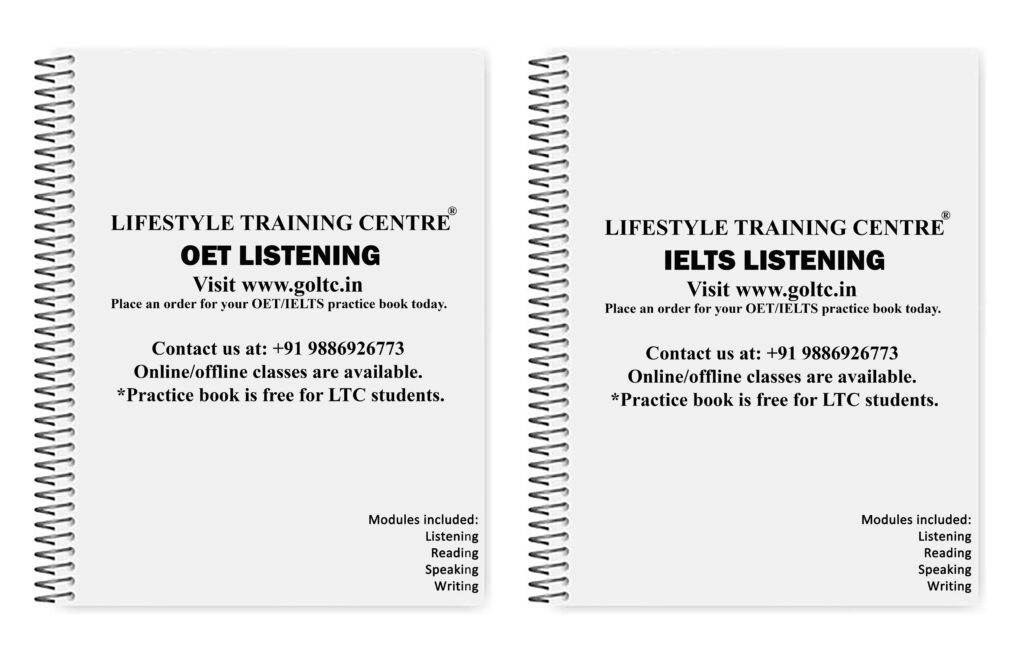In the OET writing test, you will be given a total of 45 minutes to complete your letter. The first 5 minutes are designated for reading and understanding the case notes. Only after this initial 5-minute reading period, you can start writing. You will then have 40 minutes to write your letter. It’s essential to manage your time effectively during this writing phase to ensure you complete your letter within the allotted time frame.
Watch this video to get a thorough understanding on OET letter writing:
OET Writing format by Lifestyle Training Centre (OFFICIAL)
1. Recipient’s name and address
Include the name and title of the recipient if it is given. The formal titles that can be used in OET letter writing are,
Mr
Ms (Miss or Mrs if it is mentioned)
Dr
Only skip the title if you are not sure about the person’s gender. If the name is not given, include the job title of your recipient.
Example:
District Nurse
or
The Emergency consultant
2. Date (Where to put in the date and in what format?)
The date of writing the letter can be placed either at the beginning of the letter or after the recipient’s name and address.
You can either use the full format (2nd October 2019) or just numbers with slashes (2/10/2019). Make sure if you are using slashes your date is in British format DD/MM/YYYY. It is also acceptable to use the full format at the beginning of the letter and the number with slashed inside the body of the letter.
3. The Salutation (Greeting)
The formal salutations in letters start with the word ‘Dear’ followed by the title and surname of your recipient followed by a comma
Example
Dear Dr Smith,
or
Dear Ms Johnson,
or
Dear Alex Stone, (If you are confused with the gender of the recipient.)
or
Dear District Nurse (If there is no name given, use the job title)
4. Name and the age of the patient you are referring
A good practice is to write the full name and the age of the patient here. Preferably in one line followed by a comma.
It is also acceptable to use the date of birth of the patient.
Example:
Re: Miss Jacqueline Hill, aged 27 years
Re: Miss Jacqueline Hill, 10/2/1993
Body of Letter: Remember words are only counted from here.
Ideally, the first paragraph should state your purpose of writing the letter and the following paragraphs should elaborate on the information.
INTRODUCTION: The introduction of the letter should be short and must clearly state the purpose of the letter.
Letters can begin with,
Mr Smith is being discharged back to your care
or
Thank you for seeing Mr Daniel
or
I am writing to refer Mr Jones
SUMMARY OF CHIEF COMPLAINTS: Give a detailed summary of the chief complaint in this section of the letter. (This may be multiple paragraphs depending on the nature of the letter)
SECONDARY OR ADDITIONAL INFORMATION: Add more relevant information about the patient you think your recipient should know. (Again, can be multiple paragraphs)
DISCHARGE/TREATMENT/TRANSFER PLAN AND MEDICATIONS: According to the type of letter (referral or discharge etc), this paragraph(s) should mention the plan from case notes.
CLOSING SENTENCE: This is an important part of a formal letter. Here, you are telling your recipient that you are willing to answer any questions they might have. This sentence gives a nice correspondence tone to your letter.
A common phrase is
If you have any further queries, please do not hesitate to contact me.
Always write the most important data first, then the lesser. You must keep this in mind to score a higher grade.
The End
There are mainly two ways to formally sign off a letter
Yours sincerely, (if the name of the recipient is given)
or
Yours faithfully, (if the name of the recipient is not given)
Follow this with your designation
Nurse (your designation + Name (if given))
Important! All the letters are not referrals
Many candidates start their letters with ‘I am writing to refer…’. Sometimes, this is appropriate, but not all tasks ask you to write a referral letter. Depending on the type of letter you are asked to write, there are other verbs which are equally or more appropriate. Examples of these other verbs include:
Transfer/ Discharge / Update / See / Accept / Request / Provide / Recommend
Types of OET letters
For most OET professions, there are three types of letters you will encounter:
Referral – Introducing a patient where the recipient doesn’t know the patient.
Transfer- Transferring the patient to another facility.
Discharge – Discharging the patient.
These are some of the possible formats:
- Thank you for seeing/reviewing/providing…
- I am writing to (urgently) refer/transfer/discharge/update/request…
- Mr X, your (my) patient,/ Your (My) patient, Mr X…
Profession-Specific introduction for different OET letters
1. Physiotherapist : requires assistance and management
2. Psychiatrists : requires assessment and management
3. Dietitian : requires advice and education
4. Social worker : requires support and management
5. Community nurse : requires continuity care and management
6. GP : requires follow up care and management
7. Rehabilitation center : requires rehabilitative care and management
8. Palliative care : requires palliative care and management
9. Case manager : requires coordination and management
10. Admitting officer : requires assessment and management
11. Home care agency : requires assistance with daily living activities
OET connectors/ conjunctions
- Simple connectors (also called conjunctions): and, but, or, later, as, too, because.
- Complex connectors: however, therefore, although, unless, subsequently, additionally, otherwise.
Can I use any connector to start a new sentence?
We do not recommend beginning a new sentence with some simple connectors, such as: also, so, and, but. These are fine to include in the middle of the sentence, but choose a more formal alternative for the start of your sentence, such as: Additionally, Therefore, However
What connectors should I avoid? Remember, writing a healthcare care letter to another healthcare professional is not the same as writing an essay task or academic report. Some candidates make the mistake of using the same connectors as they did for academic tasks at school or university. These may be less appropriate in the context of OET.
Some connectors are less suitable for healthcare letter writing. These include:
- Academic connectors: furthermore, moreover
- Informal connectors: besides, meanwhile, apart from that, later on
- Outdated connectors: hence, thus, thereafter
Let’s conclude:
Prioritizing important information is a crucial aspect of OET writing. By presenting the most critical data first, you not only adhere to professional writing conventions but also make your letter more effective. This ensures that the recipient quickly understands the primary concerns.
How to prioritise the letter? Keys to remember:
- Start with the Purpose: In the introduction, immediately state the purpose of the letter. This sets the context and informs the recipient of why they are receiving this letter.
- Chief Complaints: Following the introduction, provide a detailed summary of the patient’s chief complaints. This is essential information that needs to be addressed early in the letter.
- Secondary Information: After addressing the chief complaints, include any additional information that is relevant to the case. This might include the patient’s medical history, relevant test results, or other pertinent details.
- Discharge/Transfer/Referral Plan: Depending on the type of letter (referral, discharge, or transfer), outline the treatment plan, follow-up actions, or transfer process. This should be presented logically and clearly.
- Medications: When medications are a part of the patient’s care, make sure to include them in your letter. This should come after detailing the treatment plan.
- Social History: If applicable, include the patient’s social history. This may involve lifestyle factors, living conditions, or other social determinants of health. This information might come towards the end of the letter.
- Closing and Call to Action: Conclude the letter with a closing sentence that invites the recipient to seek clarification or additional information. Express your willingness to assist further.
Writing criteria for OET letter
| Purpose | Purpose of document is immediately apparent and sufficiently expanded as required |
| Content | Content is appropriate to intended reader and addresses what is needed to continue care (key information is included; no important details missing); content from case notes is accurately represented |
| Conciseness & Clarity | Length of document is appropriate to case and reader (no irrelevant information included); information is summarised effectively and presented clearly |
| Genre & Style | Writing is clinical/factual and appropriate to genre and reader (discipline and knowledge); technical language, abbreviations and polite language are used appropriately for document and recipient |
| Organisation & Layout | Organisation and paragraphing are appropriate, logical and clear; key information is highlighted and sub-sections are well organised; document is well laid out |
| Language | Language features (spelling/punctuation/vocabulary/ grammar/sentence structure) are accurate and do not interfere with meaning |
Punctuation
Correct punctuation is essential in OET writing to convey your message clearly and professionally. Here are the correct uses of the punctuation marks:
- Full Stop (.): Use a full stop at the end of a sentence to signal the completion of a thought or idea. For example:
- The patient presented with chest pain.
- Comma (,): Commas are used in several ways, such as separating items in a list or connecting independent clauses with a conjunction. For example:
- The patient has a history of hypertension, diabetes, and hyperlipidemia.
- The patient complained of shortness of breath, and the doctor prescribed an inhaler.
- Semicolon (;): Semicolons can be used to link two closely related independent clauses when you want to emphasize their connection. You can swap a semicolon with a full stop without changing the meaning. For example:
- The patient’s condition was critical; the doctor immediately ordered a CT scan.
- Hyphen (-): Hyphens are used to join two or more words to create a compound word or to clarify meaning. For example:
- The one-year-old child needed a vaccination.
Oxford comma for clarity: When listing items in a series of three or more, you should use a comma before “and” or “or” to separate the items clearly. This is known as the Oxford or serial comma. For example: The patient’s symptoms include hypertension, fever, and headache. Using the Oxford comma in this way helps avoid potential confusion and ensures that each item in the list is distinct and easily understood.
Swap commas for semi-colons: When?
Comma and semicolon in OET writing: For example: “he takes metformin, lisinopril, and atorvastatin”.
This sentence is clear because the information conveyed is simple, with commas separating the three different medications. However, as the information you need communicate becomes more complex, simple comma base list can become unclear. You might need to provide the reader with extra detail, such as the dosage and frequency of the medication.
For example: “he takes metformin, 1000mg with his evening meal, lisinopril, 10 mg, and atorvastatin, 20 mg both once a day”.
This sentence loses clarity because of all the commas, 4 in total, which means the individual medications no longer stand out as they do in the first sentence.
Swap commas for semi-colons: The simple solution to this in the second sentence is to use a semi-colon at the end of the description of each individual medication.
The commas separating the name of the medication from its dosage can remain as they retain their useful function. The second sentence will then read:
He takes metformin, 1000mg with his evening meal; lisinopril, 10 mg, and atorvastatin, 20mg both once a day.
Abbreviations in OET Writing: Avoid using abbreviations as much as possible.
Would you like to further your studies? Explore our skillfully crafted OET sample letters, meticulously aligned with the evaluation criteria. You can access them here:
OET LETTERS BY LTC OET WRITING TASKS
Do you need printed IELTS/ OET practice material? Place your order today. Available now for just Rs: 1,100 (including shipping all across India) Contact us at our WhatsApp number: +91 9886926773 to place your order. (Free for LTC students)

Free admission and English Courses. കാശ് കൊടുക്കാതെ അഡ്മിഷൻ. FREE ഇഗ്ലീഷ് കോഴ്സുകൾ. ഈ ഓഫർ നേടൂ. Contact us at +91 9886926773 പ്രോസസ്സിംഗ് ആയാസകരം.

New batch is open. Join today!

Ready to study abroad or master OET, PTE, IELTS, Duolingo, Phonetics, or Spoken English?
📞 Call us now at +91 9886926773
📱 Call/WhatsApp/Text: +91 9886926773
📧 Email: mail@goltc.in
Visit us in person by following the directions on Google Maps. We look forward to welcoming you to the Lifestyle Training Centre.
Follow Lifestyle Training Centre on social media:
Thank you very much!
Would you like to download a copy of the practice test? Please click on the download button below:

Free admission and English Courses. കാശ് കൊടുക്കാതെ അഡ്മിഷൻ. FREE ഇഗ്ലീഷ് കോഴ്സുകൾ. ഈ ഓഫർ നേടൂ. Contact us at +91 9886926773 പ്രോസസ്സിംഗ് ആയാസകരം.

New batch is open. Join today!

Ready to study abroad or master OET, PTE, IELTS, Duolingo, Phonetics, or Spoken English?
📞 Call us now at +91 9886926773
📱 Call/WhatsApp/Text: +91 9886926773
📧 Email: mail@goltc.in
Visit us in person by following the directions on Google Maps. We look forward to welcoming you to the Lifestyle Training Centre.
Follow Lifestyle Training Centre on social media:
Thank you very much!

Good job Joe , very informative explanation
Thank you, Sindhu. I am glad that you found it helpful. Best wishes